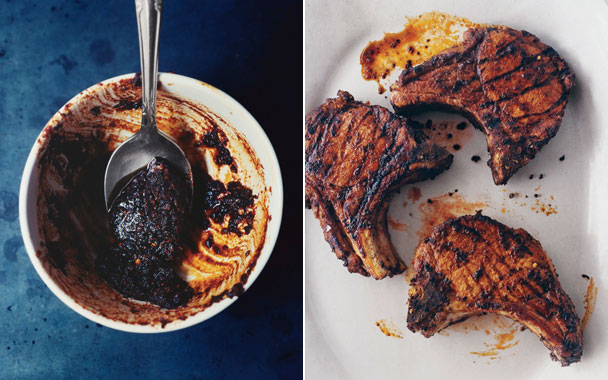We’re always looking for ways to add more flavor to grilled food. Being somewhat lazy, we’re also constantly trying to make the process quicker and easier. Like many fans of live-fire cooking, we used to rely on marinades to meet the first goal, at which they were somewhat successful. Unfortunately, they failed totally at the second goal.
Then, one languorous afternoon down in Jamaica, we found what is pretty much a magic bullet: a simple method that creates hyperflavorful grilled food with little effort.
We had just arrived in Boston Beach, the epicenter of jerk cooking, probably the Caribbean’s finest gift to cuisine. Sitting by one of the smoking pits where the masters worked their mojo, we watched one of them slather a quartered chicken with a thick, slightly grainy paste. When he handed each of us a thigh that had just come off the coals, the success of this approach became immediately apparent. In concert with the dry spices, the fresh ingredients in the paste—the aromatic fire of Scotch Bonnet chiles, the subtle herbaceousness of thyme, the pleasant allium tinge of scallions—produced a flavor complexity that surpassed even that of the dry spice rubs we were familiar with from American barbecue.
This was as close to a revelation as you’re likely to experience in the modern world. Intrigued, we began to look around for other examples of it as we traveled. As it happened, we didn’t have to search all that hard. In quick succession we discovered the chile-laced pastes of the Yucatán, the multihued curry pastes of Southeast Asia, the ubiquitous harissa of North Africa. In fact, these combinations of spices and herbs mixed with just enough oil to make them slightly gloppy turned up virtually everywhere in the daily cooking of warm climates. Each contained fresh ingredients—garlic, ginger, lemongrass, fresh chile peppers, herbs like cilantro and mint—that brought swirling layers of flavor to the mix.
Although they have many uses—Malaysia’s famous rendang paste is most often used in stews, for example—we’ve found spice pastes to be particularly well suited to grilling. To begin with, the direct high heat of the fire converts the pastes into a deep, dark, marvelously flavorful crust whose texture contrasts beautifully with the tender food inside. In this respect, they are even better than dry spice rubs, our other favorite coating for grilled food, which can burn more easily; the oil in pastes causes the spices to toast rather than dry out. (As an added advantage, this means that you don’t need to toast the spices in advance to bring out their flavor.) We also love the flavor dichotomy between the spicy crust and the unadulterated food it covers. With marinades, which do penetrate the food that sits in them, even if only slightly, this contrast is nowhere near as pronounced.
There are other reasons why spice pastes leave marinades far behind as a prefire flavoring. Because the dry ingredients in pastes are diluted only with a bit of oil rather than with the relatively large amount of liquid used in marinades, pastes contain a far more concentrated dose of spices, and therefore deliver more intense flavors. These goopy mixtures are also perfectly designed to stick to the surface of foods, so all the taste of the component ingredients stays on whatever you’re cooking, rather than being left behind, as with marinades.
And then, there is this: Spice pastes require virtually no advance planning. You can simply rub the paste liberally over whatever you’re about to commit to the mercies of the fire, pressing gently to be sure it adheres, then put the food over the coals. (That said, we have found that if you have time to let the food rest for a while, say three or four hours, after you have coated it with the spice paste, the flavor will deepen somewhat. But this certainly is not necessary.) Since most of these pastes will last for about a week, covered and chilled, they are one of those culinary secret weapons that you can have sitting on the shelf in your refrigerator, ready to deliver a full-blown, full-flavored main course in just a few minutes.
One rather surprising thing we discovered when working with spice pastes is that their flavor is much more intense while the food is still warm. Leftovers refrigerated and eaten hours or days later, while still tasty, lack that enlivening verve and boldness. So it’s best to eat these dishes within an hour or so of their coming off the grill. This should pose no problem. In our experience, food that’s been coated in a spicy paste and grilled over live fire tends to disappear from the table in far less time than that.



 Pinterest
Pinterest






